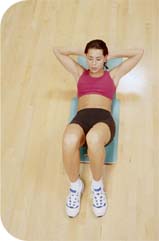|
Incredibly Healthy Self-challenges Decide with your teacher which of these activities to complete: (But hey, these are kind of cool. Try to do as many as you can!) |
 |
- What makes individual activities different from other dimensions such as games or dance? What benefits to your health can you achieve in this dimension that you don't receive by participating in other activities? Think it through and decide the best way to share your ideas with your teacher (e.g. essay, journal, presentation).
- To increase your strength participate in weight bearing activities. For example, use rubber tubing (found in most health aid stores) or soup cans for resistance. There are some great videos out there that show you how to use these. Find one that you like and get to it. Only lift free weights under direct supervision or with a buddy (most people are pretty safe with a soup can though). Monitor the progress of your strength and flexibility over a period of time. Keep track of the number of reps you can perform. Can you increase repetitions or add an extra set of reps? Take a look at the definitions below before you start.
- Ah, to just relax... Try attending a yoga class or rent a fitness video related to the topic of relaxation - an aspect of fitness that's often overlooked. Do you feel relaxed at the end of one of these sessions? Can physical activity reduce stress? Note the difference you feel at the end of a vigorous run or walk and a yoga session. Do they both have worth? Which areas of fitness do each of them affect?
- Over one week compare the time you spend on a muscular endurance workout with the time you spend on your cardio (aerobic) workouts of running, walking, etc. Pick 6 exercises that work both your upper body, lower body, and core (abdominals). Try to perform each activity 12 - 15 times for 1 - 2 sets, with a rest period of at least 90 seconds between sets. Now perform the same sequence twice, one set at a time, without the rest between sets. Compare the times required to perform each workout. What is the difference to your cardiovascular system when you don't take the rest break? Are you breathing harder?
Definitions
Repetitions: This is the number of times you can successfully and safely lift a weight or resistance in a continuous movement. You should be able to lift the weight eight times as a minimum. If this is too hard, lighten the weight or adjust the resistance. For example, if you are doing push-ups, support your body by putting your knees on the floor. If you can do the activity 20 times without fatigue you need to increase the load or resistance. If you can do 20 push-ups in a normal stretched position, make the exercise harder by placing your hands farther apart, or farther in front of your body.
Sets: This is the number
of repetitions you do in a group. You should start with one set for each
exercise. As you get stronger, you should then increase the number of
sets you do. You should not need to do more than three sets of any one
exercise. Sets should consist of 8 - 20 reps. E.g. Place the soup can
in your hands (weights, resistance) arms extended, palm down or up. Lift
the can, approximately 6 inches 8 times (repetitions). After 8 times rest
90 seconds and then repeat. (You have just done 1 set going onto a second
set) Repeat this number of repetitions (8) three times (3 sets).

activities | health benefits | cooperation | do it daily for life
